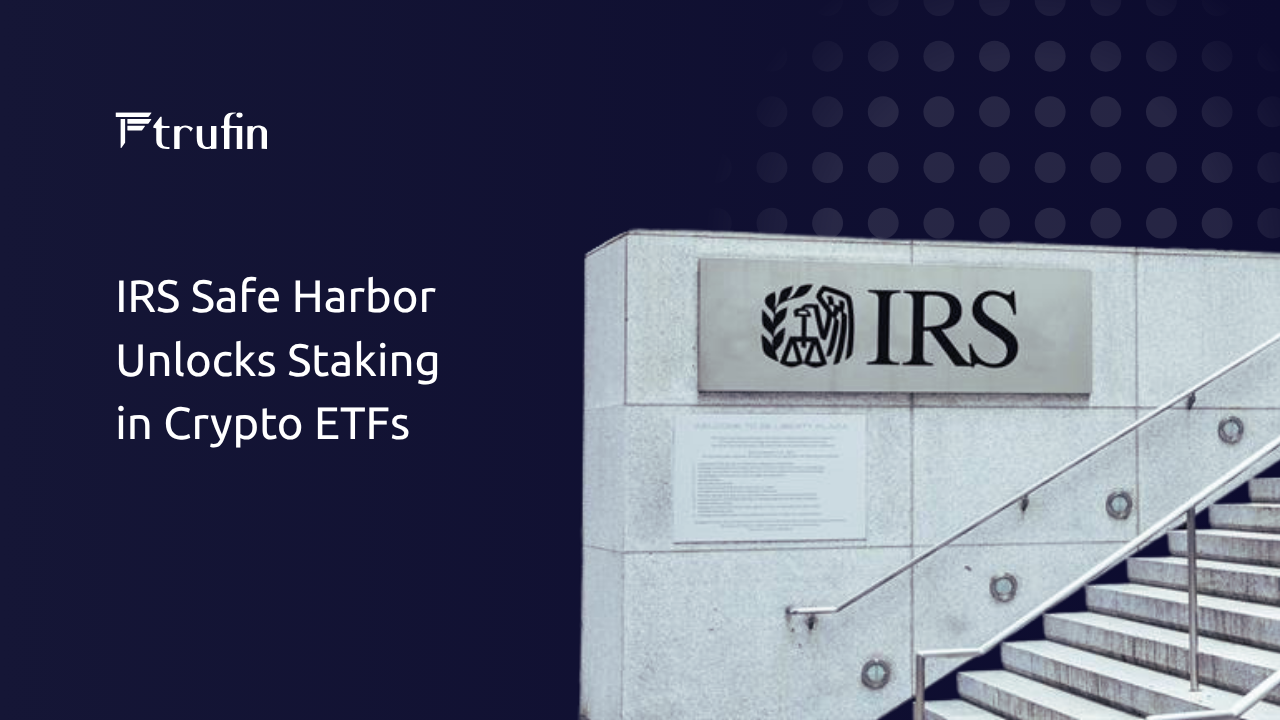November 13, 2025

In November 2025, the US Treasury and Internal Revenue Service (IRS) released Revenue Procedure 2025-31, establishing a formal tax safe harbor for crypto investment trusts and exchange-traded products (ETPs) that participate in proof-of-stake (PoS) staking.
For the first time, regulated crypto ETFs and trusts holding a single PoS asset may stake those holdings and distribute rewards to investors without compromising their pass-through tax status.
This guidance removes a critical barrier that had kept staking outside the scope of compliant, exchange-listed products. It is a shift that will reshape how institutions access on-chain yield.
What Has Changed
The new IRS framework clarifies that a qualifying crypto fund can engage in staking without being treated as an active business, provided it satisfies a defined set of conditions.
Funds operating under the safe harbor can:
Stake PoS assets such as ETH or SOL through independent validators.
Maintain their grantor-trust or pass-through tax treatment.
Distribute staking rewards to investors as income under standard reporting mechanisms.
This change harmonises tax treatment with the growing securities-law recognition of staking and eliminates a key point of regulatory ambiguity for issuers, custodians, and investors.
Market Impact
The introduction of this safe harbor could have far-reaching consequences for the structure and competitiveness of crypto investment products.
For ETF and ETP Issuers
The ability to incorporate staking transforms single-asset crypto products into yield-generating vehicles. Issuers can now differentiate on net yield, validator strategy, liquidity design, and transparency. These themes will drive the next phase of competition in digital-asset fund management.
For Institutional Investors
Asset managers, private banks, and platforms gain access to staking income through regulated wrappers. Yield that previously required operational complexity or self-custody can now be accessed within familiar compliance, reporting, and custodial frameworks.
For Custodians and Staking Providers
The ruling elevates the role of independent custodians and enterprise staking operators as critical partners to fund issuers. Meeting safe harbor requirements will demand enhanced segregation, auditability, and infrastructure resilience.
For the Broader Ecosystem
As regulated funds accumulate and stake assets, the overall proportion of network supply held in institutional custody will increase, strengthening network security while creating new dynamics for liquidity and redemption management during validator lockups or market stress.
Implementation and Compliance
The guidance is effective immediately, with a transitional period for existing trusts to amend their governing documents.
To qualify, funds must demonstrate:
Single-asset focus, with only incidental cash balances.
Independent validator operation via a third-party provider.
Qualified custodian control of private keys.
Prohibition of other business activities, such as lending or trading.
Liquidity protocols that ensure redemptions despite staking lockups, aligned with SEC disclosure standards.
Failure to adhere to these parameters could forfeit the safe harbor protection and alter a fund’s tax classification. This underscores the need for strong operational governance and legal oversight.
Global Regulatory Alignment
This IRS ruling arrives amid a global movement towards formalising institutional staking frameworks. In the EU, the MiCA regime is setting disclosure and risk-management standards for crypto service providers. In the Middle East, the Abu Dhabi Global Market (ADGM) has established a clear regulatory path for institutional staking under defined custodial and operational conditions, as highlighted in our recent ADGM insights article.
The US safe harbor complements these developments and signals that staking is no longer viewed as incompatible with regulated financial structures. It bridges a long-standing divide between traditional fund mechanics and on-chain yield generation, positioning staking as a legitimate, income-oriented strategy within institutional portfolios.
TruFin’s Perspective
At TruFin, we view this guidance as a foundational step in the maturation of the digital-asset industry. It affirms the principle that staking can operate within regulated, auditable, and institutionally aligned frameworks, provided proper safeguards are in place.
Through the TruFin Protocol, we are building the infrastructure that enables financial institutions to access staking and yield opportunities across leading PoS networks securely, compliantly, and with full transparency.
This development further validates our approach, bridging traditional finance and decentralised infrastructure through robust integration with custodians, exchanges, and validators.
Looking Ahead
The integration of staking into ETFs and ETPs will redefine how institutional investors perceive and allocate to digital assets.
Key areas to watch in 2026 include:
Yield transparency and reporting: Fund issuers will compete on disclosure clarity and after-tax yield performance.
Validator assurance frameworks: Expect new standards around uptime, slashing coverage, and operational resilience.
Liquidity innovation: Mechanisms that allow redemptions during lockups, potentially through liquid staking or synthetic structures, will become differentiators.
Cross-market adoption: Other jurisdictions are likely to follow the US lead, creating harmonised pathways for staking inside regulated fund vehicles.
As competition intensifies, operational excellence will determine market leadership. Those who align early with compliance-ready staking frameworks will be best positioned to capture institutional inflows.
Conclusion
The IRS safe harbor marks a watershed for institutional crypto. It delivers the clarity needed for ETFs and ETPs to integrate staking yield without tax uncertainty, transforming how on-chain income can flow through traditional financial structures.
For issuers, it unlocks a new generation of regulated yield products. For investors, it offers access to staking income within trusted, compliant wrappers. And for the digital-asset ecosystem, it signals a decisive step towards the full institutionalisation of on-chain yield.
Partner with TruFin
TruFin Labs is partnering with fund sponsors, custodians, and staking providers to advance regulated, yield-enabled solutions for institutional investors.
If your organisation is exploring how to structure staking-enabled funds, integrate validator operations, or align custody and compliance frameworks, connect with us to learn how TruFin can support your digital-asset yield strategy.